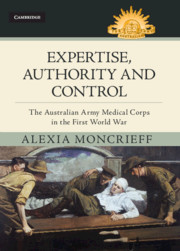Book contents
- Expertise, Authority and Control
- Other titles in the Australian Army History Series
- Expertise, Authority and Control
- Copyright page
- Contents
- Figures, maps and tables
- Preface
- Acknowledgements
- Note on style
- Abbreviations
- Introduction
- Chapter 1 Gallipoli
- Chapter 2 Medicine in the lines
- Chapter 3 The Western Front in 1918
- Chapter 4 A pleasant dose of medicine?
- Chapter 5 The most difficult problem
- Conclusion
- Notes
- Bibliography
- Index
Chapter 4 - A pleasant dose of medicine?
The purpose, place and practice of auxiliary hospitals
Published online by Cambridge University Press: 10 February 2020
- Expertise, Authority and Control
- Other titles in the Australian Army History Series
- Expertise, Authority and Control
- Copyright page
- Contents
- Figures, maps and tables
- Preface
- Acknowledgements
- Note on style
- Abbreviations
- Introduction
- Chapter 1 Gallipoli
- Chapter 2 Medicine in the lines
- Chapter 3 The Western Front in 1918
- Chapter 4 A pleasant dose of medicine?
- Chapter 5 The most difficult problem
- Conclusion
- Notes
- Bibliography
- Index
Summary
In November 1914, an Australian couple living in Middlesex, England, offered their house for use as a convalescent home for sick and wounded Australian soldiers recovering from injury. The AAMC accepted Mr and Mrs Charles Billyard-Leake’s offer, and their house and its grounds, Harefield Park, became a convalescent hospital before eventually becoming 1st Australian Auxiliary Hospital (1AAH) Harefield. The AAMC originally intended it to house fifty to a hundred patients plus staff but, eight months after opening, the accommodation had been increased to provide a thousand beds for convalescing soldiers. While at least one soldier mused that its purpose was to house those who were not ‘fit to die in their own homes’, its main function was to rehabilitate sick and wounded soldiers for a return to duty.1 The hospital eventually included surgical, medical, X-ray, massage and electric therapy as well as recreation and study departments. Along with the other auxiliary hospitals in the Australian network – 2nd Australian Auxiliary Hospital (2AAH), Southall, and 3rd Australian Auxiliary Hospital (3AAH), Dartford – it formed an integral part of the medical services provided to Australian soldiers wounded in the First World War.
- Type
- Chapter
- Information
- Expertise, Authority and ControlThe Australian Army Medical Corps in the First World War, pp. 109 - 140Publisher: Cambridge University PressPrint publication year: 2020

